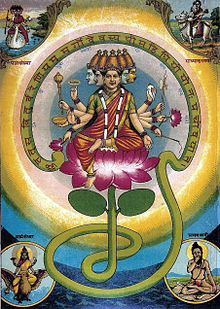
Back গায়ত্ৰী মন্ত্ৰ Assamese Mantra Gayatri BAN Гаятри мантра Bulgarian गायत्री मंत्र Bihari গায়ত্রী মন্ত্র Bengali/Bangla Mantra Gayatri Catalan Gayatri-Mantra German गायत्री मन्त्र DTY Gāyatrī Spanish Gayatri-mantra Finnish

| Part of a series on |
| Hinduism |
|---|
 |

The Gāyatrī Mantra (Sanskrit pronunciation: [ɡaː.jɐ.triː.mɐn.trɐ.]), also known as the Sāvitrī Mantra (Sanskrit pronunciation: [saː.vi.triː.mɐn.trɐ.]), is a sacred mantra from the Ṛig Veda (Mandala 3.62.10),[1] dedicated to the Vedic deity Savitr.[1][2] It is known as "Mother of the Vedas".[3]
The term Gāyatrī may also refer to a type of mantra which follows the same Vedic metre as the original Gāyatrī Mantra. There are many such Gāyatrīs for various gods and goddesses.[3] Furthermore, Gāyatrī is the name of the Goddess of the mantra and the meter.[4]
The Gayatri mantra is cited widely in Hindu texts, such as the mantra listings of the Śrauta liturgy, and classical Hindu texts such as the Bhagavad Gita,[5][6] Harivamsa,[7] and Manusmṛti.[8] The mantra and its associated metric form was known by the Buddha.[9] The mantra is an important part of the initiation ceremony. Modern Hindu reform movements spread the practice of the mantra to everyone and its use is now very widespread.[10][11]
- ^ a b "Rig Veda: Rig-Veda, Book 3: HYMN LXII. Indra and Others". www.sacred-texts.com. Retrieved 29 September 2020.
- ^ "Gayatri Mantra". OSME.
- ^ a b Swami Vishnu Devananda, Vishnu Devananda (1999). Meditation and Mantras, p. 76. Motilal Banarsidass Publ.
- ^ Staal, Frits (June 1986). "The sound of religion". Numen. 33 (Fasc. 1): 33–64. doi:10.1163/156852786X00084. JSTOR 3270126.
- ^ Rahman 2005, p. 300.
- ^ Radhakrishnan 1994, p. 266.
- ^ Vedas 2003, p. 15–16.
- ^ Dutt 2006, p. 51.
- ^ Shults, Brett (May 2014). "On the Buddha's Use of Some Brahmanical Motifs in Pali Texts". Journal of the Oxford Centre for Buddhist Studies. 6: 119.
- ^ Rinehart 2004, p. 127.
- ^ Lipner 1994, p. 53.